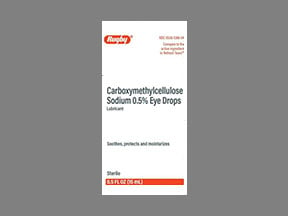
Lubricant Eye Drops Coupons & Savings Card – Discount Prices from $11.74
Brand for: Carboxymethylcellulose
This medication is used to relieve dry, irritated eyes. Common causes for dry eyes include wind, sun, heating/air conditioning, computer use/reading, and certain medications. This product may contain 1 or more of the following ingredients: carboxymethylcellulose, dextran, glycerin, hypromellose, polyethylene glycol 400 (PEG 400), polysorbate, polyvinyl alcohol, povidone, or propylene glycol, among others. Eye lubricants keep the eye moist, help to protect the eye from injury and infection, and decrease symptoms of dry eyes such as burning, itching, and feeling as if something is in the eye.
Our Lubricant Eye Drops coupons are free to use. You can print the coupon, email it to yourself, or receive the Lubricant Eye Drops coupon via text message. To get your free discount, show the pharmacist your Lubricant Eye Drops savings card which has the discounted coupon price. Use our filters below to edit the prescription box to match your needs. The Lubricant Eye Drops prices will update based on your prescription needs. Above our Lubricant Eye Drops coupons, you can change the location to see pharmacy prices in other areas. Our prescription discount card will update online with the specific pharmacy costs associated with your edits. Be sure to text, email, or print the Lubricant Eye Drops savings card code that you need after editing the prescription box and location field. Show the discount card to your pharmacist before paying.
My prescription
Edit
15ML of 0.5%, Carboxymethylcellulose (1 Bottle)
Select pharmacy

Albertsons
$11.74
COUPON PRICE
Walgreens
$11.74
COUPON PRICELubricant Eye Drops savings card
Show this card to your pharmacist
Albertsons
$11.74
BIN
ID
PCN
GRP
011867
LH884A15CA
HT
LABH001
Powered by
This medication is used to relieve dry, irritated eyes. Common causes for dry eyes include wind, sun, heating/air conditioning, computer use/reading, and certain medications. This product may contain 1 or more of the following ingredients: carboxymethylcellulose, dextran, glycerin, hypromellose, polyethylene glycol 400 (PEG 400), polysorbate, polyvinyl alcohol, povidone, or propylene glycol, among others. Eye lubricants keep the eye moist, help to protect the eye from injury and infection, and decrease symptoms of dry eyes such as burning, itching, and feeling as if something is in the eye.
Our Lubricant Eye Drops coupons are free to use. You can print the coupon, email it to yourself, or receive the Lubricant Eye Drops coupon via text message. To get your free discount, show the pharmacist your Lubricant Eye Drops savings card which has the discounted coupon price. Use our filters below to edit the prescription box to match your needs. The Lubricant Eye Drops prices will update based on your prescription needs. Above our Lubricant Eye Drops coupons, you can change the location to see pharmacy prices in other areas. Our prescription discount card will update online with the specific pharmacy costs associated with your edits. Be sure to text, email, or print the Lubricant Eye Drops savings card code that you need after editing the prescription box and location field. Show the discount card to your pharmacist before paying.
Our Lubricant Eye Drops coupons are free to use. You can print the coupon, email it to yourself, or receive the Lubricant Eye Drops coupon via text message. To get your free discount, show the pharmacist your Lubricant Eye Drops savings card which has the discounted coupon price. Use our filters below to edit the prescription box to match your needs. The Lubricant Eye Drops prices will update based on your prescription needs. Above our Lubricant Eye Drops coupons, you can change the location to see pharmacy prices in other areas. Our prescription discount card will update online with the specific pharmacy costs associated with your edits. Be sure to text, email, or print the Lubricant Eye Drops savings card code that you need after editing the prescription box and location field. Show the discount card to your pharmacist before paying.
Lubricant Eye Drops FAQs
Using the SaveHealth discount card, what is the price of Lubricant Eye Drops without insurance?
Using the SaveHealth discount card, the price of Lubricant Eye Drops without insurance is $11.74.
What is the price of Lubricant Eye Drops at Walgreens?
The price of Lubricant Eye Drops at Walgreens is $11.74.
